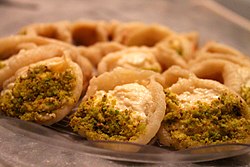Qatayef: Difference between revisions
Dalal 1999 (talk | contribs) No edit summary |
יניב הורון (talk | contribs) more specific, not from the Arabian peninsula or Mesopotamia, but from the Levant (which is not exclusively Arab) |
||
| Line 16: | Line 16: | ||
| other = |
| other = |
||
}} |
}} |
||
'''Qatayef''' or '''Katayef''' ({{lang-ar|قطايف}}, {{IPA-ar|qā'ṭā:īf||Qatayef ar.ogg}}) is |
'''Qatayef''' or '''Katayef''' ({{lang-ar|قطايف}}, {{IPA-ar|qā'ṭā:īf||Qatayef ar.ogg}}) is a Levantine dessert commonly served during the month of [[Ramadan]], a sort of sweet [[dumpling]] filled with cream or nuts. |
||
==Etymology== |
==Etymology== |
||
Revision as of 00:34, 2 September 2018
 | |
| Type | Dumpling |
|---|---|
| Place of origin | Levant, Middle East |
| Region or state | Egypt, Iraq, Jordan, Lebanon, Palestine, Saudi Arabia and Syria |
| Main ingredients | unsalted cheese, or a mixture of hazelnuts, walnuts, almonds, pistachios, raisins, powdered sugar, vanilla extract, and cinnamon |
Qatayef or Katayef (Template:Lang-ar, [qā'ṭā:īf] ) is a Levantine dessert commonly served during the month of Ramadan, a sort of sweet dumpling filled with cream or nuts.
Etymology
The Arabic word Qatayef (Template:Lang-ar) is derived from the Arabic verb Template:Lang-ar, meaning to pick up.[1]
Origin
Qatayef is of Fatimid origin.[2] Some believe that Qatayef are the creation of the Fatimid Dynasty,however, their history dates back to the Abbasid Caliphate, 566-653 CE.[3][4] Qatayef was mentioned in a tenth century Arabic cookbook dates back to the Abbasid Caliphate by Ibn Sayyar al-Warraq called Kitab al-Ṭabīḫ (Template:Lang-ar, The Book of Dishes).[5] The book was later translated by Nawal Nasrallah, and named it (Annals of the Caliphs' Kitchens).[6] Qatayef was traditionally prepared by street vendors as well as households in the Levant and Egypt. It is usually prepared using Akkawi cheese as a filling.[7][8]
Preparation
Qatayef is the general name of the dessert as a whole, but more specifically, the batter. The result of the batter being poured onto a round hot plate appears similar to pancakes, except only one side is cooked, then folded. The pastry is filled with either unsalted cheese or a mixture of any of hazelnuts, walnuts, almonds, pistachios, raisins, powdered sugar, vanilla extract, and cinnamon. It is then deep-fried or, less commonly, baked and served with a hot syrup or sometimes honey.[9][10]
See also
References
- ^ Team, Almaany. "Definition and meaning of Qatayef in Arabic - Arabic dictionary - Page 1". www.almaany.com.
- ^ The Ramadan Experience in Egypt
- ^ life, style. "The sweet history of Qatayef". Roya news. Retrieved 26 August 2018.
- ^ 1, 2. "In Gaza, Qatayef tradition thrives during Ramadan". GULF NEWS. Retrieved 26 August 2018.
{{cite web}}:|last1=has numeric name (help) - ^ al-Warrāq, Ibn Sayyār; Nasrallah, Nawal (Nov 26, 2007). Annals of the Caliphs' Kitchens: Ibn Sayyār Al-Warrāq's Tenth-century Baghdadi Cookbook. BRILL. p. 422. Retrieved 30 August 2018.
- ^ al-Warrāq, Ibn Sayyār; Nasrallah, Nawal. "Annals of the Caliphs' Kitchens: Ibn Sayyār Al-Warrāq's Tenth-century Baghdadi Cookbook". books. Retrieved 30 August 2018.
- ^ Sadat, Jehan (2002). A Woman of Egypt. Simon & Schuster. p. 48.
- ^ Abu-Zahra, Nadia (1999). The Pure and Powerful: Studies in Contemporary Muslim Society. Ithaca Press. ISBN 9780863722691.
- ^ "Qatayef with nuts قطايف بالمكسرات | Egyptian Cuisine and Recipes". egyptian-cuisine-recipes.com. Retrieved 2018-03-14.
- ^ Katayef (Ramadan pancakes) This Week in Palestine, Turbo Computers & Software Co. Ltd. 2007-07-09 Accessed on 2008-01-07.
